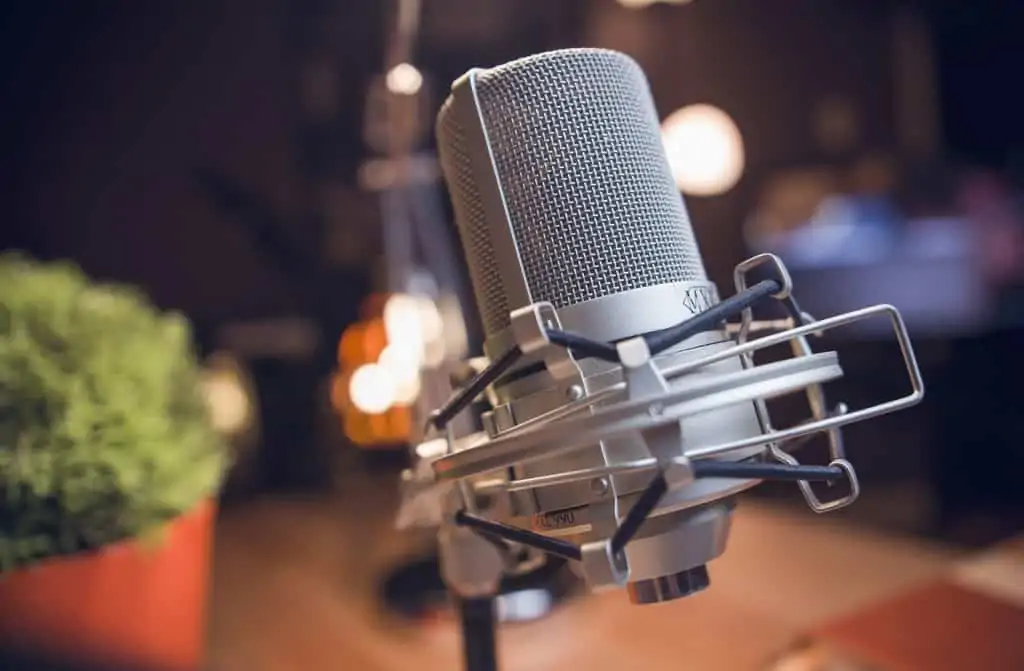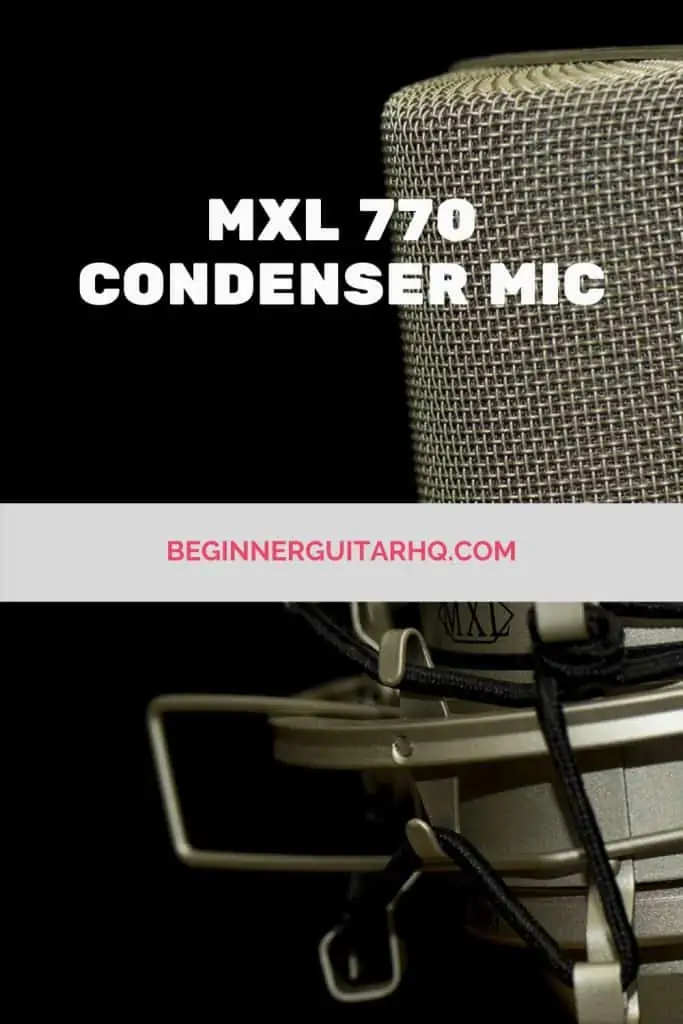MXL is a Marshall Electronics’ brand. It currently leads the pro audio gears and, in particular, the microphone segment. Today, we bring the MXL 770, one of the most popular condenser microphones in existence.
Coming from their California headquarters, the MXL is an entry-level condenser microphone suited for home studios, podcast applications, voice recording, and similar.
As an XLR microphone, it needs an extra audio interface to work, unlike other USB mics we’ve reviewed. In particular, we recently reviewed the ART2000, and we highlighted the differences between USB and XLR microphones. We’re going to re-check on that fact later on.
Either way, the MXL 770 is a cardioid condenser microphone that comes in a small and sturdy package. It’s also very affordable, especially considering the multiple applications it has.
The 770 model is an evolution of the MXL 990, so it comes into the market with a huge fan base. Nevermind the reputation of its predecessor, the MXL 770 continues to achieve strong sales, reviews, and recommendations.
Most definitely, you’re reading about one of the most competitive microphones in the market. If you’re a YouTube, a podcaster, a small radio host, or the owner of a home studio, the MXL 700 might just be the thing for you.
The MXL 770 is a best seller condenser microphone.
We’ve already made a list of the best home studio microphones, which are mostly condenser mics. Check the guide for further options.
Contents
MXL 770 Cardioid Condenser Microphone Review
During the golden age of top-value and affordable microphones, finding a great budget microphone is not at all hard these days.
However, when brands like MXL come with a sub $100 street price for the 990 successors, you should turn your head. I mean, if you’ve seen a couple of YouTube vloggers, you’ve probably already seen one of the two.
However, MXL is known as a budget mic manufacturer. Their options range from office solutions to studio alternatives. And while there’s not much to find at higher price brackets, few would say MXL mics aren’t for professionals.
So, many recognize MXL as a name of budget microphones. However, the MXL is not a sub-par item. First of all, it comes with a low-profile shock mount, a spider mount. Then, it does a fine job with various types of sound sources, which include acoustic instruments, percussion, and voices.
More importantly, it ships with a nice carrying case.
That said, the top features to remember about the 770 are:
- Cardioid
- XLR
- Medium-diaphragm
- Condenser
Overview
Underneath its metal hood, the MXL 770 has a gold-sputtered small diaphragm with six microns. All of this jargon means the mix is capable of covering sounds ranging from 30Hz (like the lowest notes of an electric guitar) to 20kHz (a cricket, maybe?)
It also has a low-noise FET preamp, which helps to erase unwanted sounds and background noises.
Note it comes with an XLR connection plus a 48v phantom power requirement. Only interfaces and audio mixers provide phantom power on some of their inputs. If you need one of these audio devices, check this list featuring the best cheap alternatives.
I’m closing this section with an MXL 770 bundle that includes a fixed boom mic stand, and a pop filter:
Build Quality
The MXL 770 comes in a matte charcoal finish atop a metal body. It also has gold lettering at the front to showcase the “MXL 770” name, plus a gold trim beneath the capsule.
Right out of the box, there’s nothing spectacular about the microphone. It jumps to the eye the lack of a gain knob at the front of the mic, which means you’ll need to rely on the interface for volume control.
On the back, there’s a -10Db attenuation switch, plus a bass roll-off switch. Both buttons give you some extra control and versatility.
However, I still find the overall design elegant. The golden details add a vintage spice to it. Plus, the black body and chassis grille are nothing but classical.
More importantly, it has a sturdy and light metal chassis. Even though it’s lighter than a higher-end microphone, you can rest assured it’s not a flimsy little microphone. On the contrary, it’s quite durable, and so it can take a beating on your studio.
Dynamic microphones typically have a round head. They are suited for the stage, as they are sturdier and can receive more punishment.
A multi-use cardioid microphone
As it has a cardioid pattern, it picks up sounds coming from the front, while cutting sounds coming from every other direction.
And like I said before, the MXL 700 is a versatile microphone. You could use it for acoustic pianos, electric guitar cabinets and amplifiers, keyboard cabinets, percussion (albeit not the drum kick), and voices.
In particular, the voice department includes voice-overs, narration, YouTube videos, YouTube vlogs, streaming, video-calls, podcasts, advertising recording, and such.
Its downside is its single pattern, but you would have to search above the $110 price mark for microphones delivering multi-pattern options. Also, it’s possiblñe to find single-pattern mics selling for 10 times the price of the MXL 770.
With the presence of the attenuator switch plus the low-frequency roll-off, you have some extra options. For example, you can turn on the bass cut to record deep voices or acoustic strings, and so the result has more presence at the mids.
Or you could use the attenuation pad when the mic is sitting too close to a noisy signal, or when a person’s voice is uncomfortably above everything else during live streaming.
Medium-sized diaphragm design
The MXL 770 has a 0.87’’ capsule, which is an odd choice. Small diaphragms go from 0.25’’ to 0.5’’, and they are capable of recording subtle sounds with extra precision and crips.
Large-diaphragms typically go from 0.9’’ to 1.5’’, and they produce stronger and richer outputs.,
The 770 falls right in-between, which is also part of its versatility, but it also loses the ability to capture 20Hz sounds, which is why you wouldn’t want to record a bass guitar, a drum kick, or a super-deep voice with the 770 model.
It also has a 74 dB signal-to-noise ratio, which means distance (measure in dB for volume) between the noise floor and the least hearable audio the mic captures.
In comparison, something like the over $3000 Neumann U87 (a gold standard) has an 82 dB signal-to-noise ratio plus a 20Hz-20kHz frequency rate. It also has a 1’’ diaphragm, which is why it is capable of capturing whisper-quiet sounds.
Still, a 74 dB level is pretty good. You’d still need to do some tweaking and post-producing on your voice records. But, assuming that you know your way around a voice program like Adobe Audition, you’ll clean-up your voice pretty quickly.
Speaking of which, check this video tutorial on improving your voice audio:
Crunching the numbers, it’s safe to consider the MXL 700 as a top performer. In fact, you’d be hard pressed to find $3000 of difference between the 770 and the professional U87 model.
Condenser accuracy
There’s no reason to skip a condenser microphone on the studio, or to use a dynamic microphone outside of the stage, for that matter.
Previously, the reason was condenser mics were more expensive than their sturdy counterparts. That’s because these are more delicate, accurate, and capable of capturing the sound with more precision.
But with budget alternatives coming from MXL, you’re all set for the quality every studio needs.
See, microphones with a large-diaphragm tend to deliver top-notch performance and output for vocals. Not every mic packing a big capsule can do it though, certainly not at the level of the U87 model. But the general idea is to get a microphone that adds sparkle, and crispiness to the voices.
A lesser-quality mic would add snap, pop, crackle, noises, and clicks. It would also deliver a lower output and a damaging signal-to-noise ratio. That means you would have to work your way around on post-production to make it sound better.
On the other hand, the MXL 770 ensures good-quality voices coming out right of the box. And it does add sparkle and crips, which means it accentuates the mid-range sounds to make your voice more present and significantly above the noise floor.
Naturally, that means you don’t need to do much in post-production to make it great, although you would always need, at least, equalization and compression at this segment.
Additionally, the MXL 700 delivers a great quality during live streams, where you don’t have the opportunity to tweak the voice.
The shockmount has the primordial duty of keeping the microphone tight and protected while you record.
Mid-range booster performance
Now, checking the numbers, you’ll find the MXL 770 bumps the high-frequency sounds between 5,500 Hz and 9,000 Hz. That’s well-suited for voices, keyboards, guitars, and similar.
With these qualities, the MXL 700 delivers crystalline vocal quality. At the same time, the 770 excels at acoustic guitars, ukuleles, mandolins, resonators, and similar acoustic instruments. That’s because these full-range instruments can benefit from a microphone that enhances the mid-range frequency sounds.
For a sub $100, the MXL 770 sounds incredibly smooth. It’s popular for a reason, and I believe it can blow anyone away.
In particular, it shines in vocals as it can deliver lifelike sounds with no coloration, plenty of output, little noise, and extra clarity. At the same time, it adds some warmth and roundness to the signal.
It also has a higher SPL compared to the 990, which is why you could use it to record instruments as well, even if you record an amplifier. The older 990 is not very good at that department.
Then, the low-frequency switch can eliminate boomy sounds, while the 10Db pad gives you some extra leeway with louder instruments.
However, remember this is a cardioid mic, so remember to place it directly in front of the sound source. That means it won’t capture, for example, the echo created by an open-back guitar cabinet.
Overall, I can describe the sounds it captures as clear, crips, and sparkly. Also, the MXL 770 achieves these qualities, without introducing noises or sibilance sounds, which is typical for microphones at this price range.
Lastly, as with every condenser microphone, the MXL 770 requires 48 volts of phantom power for its 150 ohms of impedance. That delivers a maximum sound pressure level (SPL) of 137 dB, which means it’s capable of recording super-heavy drums, for example.
Downsides & Alternatives
I wouldn’t say the MXL 770 has any downsides, although you can certainly look elsewhere for other alternatives.
Here on the site, we reviewed the Audio-Technica AT2035 is the best mic you could you to record acoustic guitar. As a dedicated mic for the task, it will deliver the best performance possible.
Compared to the MXL 770, the AT2035 is capable of capturing subtle sounds with more precision. For example, a soft arpeggio will sound better on the AT2035 than on the MXL 770.
Another option I can recommend is the AKG P420. It’s a condenser microphone with a switch to change between different pickup patterns, which adds extra versatility. The quality is also very good, but it doesn’t shine on voice-overs in particular, as it’s more oriented for singers and instruments.
If you don’t have an interface, you could save up the money and go for a USB microphone. USB microphones have an onboard sound chip that converts the digital signal into an analog signal.
That means the quality can’t go as high as an interface, as the audio quality of an audio interface is always higher than what USB mics can deliver. And though most people wouldn’t hear much of a difference, the extra quality gives you more room to work on post-production.
Either way, I recommend the Elgato Wave as a premium USB for a podcast, streaming, and similar applications mic:
MXL 770 mic specs
- Cardioid pickup pattern
- 0.87’’ diapragphm
- 30Hz – 20kHz frequency response
- 15mV/Pa sensitivity
- 150 ohms input impedance
- 0 dB , -10dB attenuation pass
- 6 dB/octave high pass filter
- 74 dB S/N ratio
- 137 dB max SPL
- 48V phantom power requirement
You can read the full specs on the official page.
In Summary
While the MXL 770 is not the best of the best, it’s pretty close to the top-tier and very expensive Neumann U87. And it’s close in both specs and performance.
That means, for most applications, you don’t need anything extra. You won’t find any difference, hence you’d be throwing away your money. In some cases, the MXL 770 might even be better at recording voices, but it might not be as good as dedicated instrument microphones.
As it is, the MXL 770 is a bargain for both professionals and amateurs. If you’re looking for something extra specific, then you might search around for dedicated microphones instead.
Final Say
The MXL 770 looks great, has a lasting chassis, and delivers a high-performance sound. Honestly, it belongs at a much higher price bracket.
Go ahead and give them your money.




